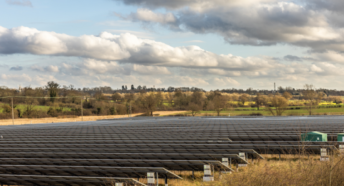Communities help to plan low carbon future
Local communities have a new way to help the country meet its obligation to tackle climate change, following this month’s approval of the historic Paris Agreement [1]. With the need to develop a genuinely sustainable energy system more pressing than ever, a new consultation tool published today [30 November] lets towns, villages and neighbourhoods shape their own genuinely sustainable local energy plans.
Published by the Centre for Sustainable Energy (CSE) and CPRE, it aims to bring communities together to share their passion for local landscapes with their enthusiasm for a more sustainable future.


CSE and CPRE’s new ‘Future Energy Landscapes’ approach shows that putting local people at the centre of energy planning can result in ambitious vision and targets. Through a series of participatory workshops, with visual tools and consumption calculations, communities are empowered to combine their understanding and views of their landscape with planning for energy needs Together, local planners and communities can create robust energy strategies that could deliver radical reductions in carbon emissions and enjoy genuine local backing.
Rachel Coxcoon, Head of Local & Community Empowerment at CSE, who led the research, says: “Our aim was to develop a new approach to energy planning that would reduce local opposition to new energy infrastructure, by putting local people at the heart of the process of choosing what’s appropriate for their area. Communities who trialed this approach developed plans for future energy developments that were ambitious in scope, but grounded in local realities”.
Kim Hagen, Senior Energy Campaigner at CPRE, comments: “Moving towards a low carbon future needs to happen in a socially just way that doesn’t harm the countryside. This new approach puts communities in the driving seat for energy planning, ensuring local voices are valued and increasing local pride in shaping the energy transition we urgently need. At the same time, the approach puts landscape character at the heart of renewable energy planning, simply by carefully listening to those who live in, and care for, their local area.
“With the Paris Agreement meaning that people are now working globally towards a low carbon future, this energy planning approach encourages local communities to do their bit.”
[1] On 18 November, the UK formally ratified the Paris Agreement to the UN Framework Convention on Climate Change, which came into force on 4 November. More information is here:
https://www.gov.uk/government/news/uk-ratifies-the-paris-agreement
- A number of important documents have yet to emerge. For example, a rigorous transport plan and a finalised air-quality assessment. The latter is critical given that allocations at Teynham will feed extra traffic into AQMAs.
- There seems to be no coherent plan for infrastructure delivery – a key component of the plan given the allocations being proposed near the already crowded Junction 7.
- There seems to have been little or no cooperation with neighbouring boroughs or even parish councils within Swale itself.
The removal of a second consultation might have been understandable if this final version of the plan were similar to that being talked about at the beginning of the consultation process. It is, however, radically different in the following ways:
- There has been a major shift in the balance of housing allocations, away from the west of the borough over to the east, especially around the historic town of Faversham. This is a move that raises many concerns.
- A new large allocation, with accompanying A2 bypass, has appeared around Teynham and Lynsted, to which we are objecting.
- Housing allocations in the AONB around Neames Forstal that were judged “unsuitable” by the council’s own officers have now appeared as part of the housing numbers.
- Most of the housing allocations being proposed are on greenfield sites, many of them on Grade 1 agricultural land – a point to which we are strongly objecting.
Concerns about the rush to submit the plan
The haste with which the plan is being prepared is especially worrying given the concentration of housing in Faversham. If the town is to take a large amount of new housing, it is imperative that the policies concerning the area are carefully worked out to preserve, as far as possible, the unique nature of the town. The rush to submit the plan is likely to prove detrimental.
As Swale does not have a five-year land housing supply, it is open to speculative development proposals, many of which would run counter to the ideas contained in the current plan. Some are already appearing. This is a common situation, and one that, doubtless, is a reason behind Swale’s haste.
Our overriding fear, however, is that this emphasis on haste is ultimately going to prove counterproductive. This is because it is our view that the plan, in its current form, is unlikely to pass independent examination. We are urging Swale to listen to and act upon the comments being made about the plan and to return the plan to the council with appropriate modifications before submitting it to the Secretary of State.
Essentially, this means treating the current consultation not as the final one but as the ‘lost’ second consultation.
The consultation ends on Friday 30 April and we strongly urge residents to make their opinions known if they have not already done so.
Further information








